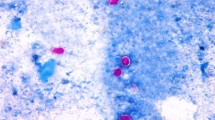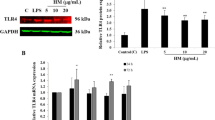Abstract
Objective
To explore the significance of colonic epithelial cell apoptosis and tumor necrosis factor α (TNF-α) changing in pathogenesis of melanosis coli (MC) in guinea pig and the molecular mechanism of rhubarb (Rhu) in inducing the disease, by means of using different dosages of Rhu to induce the disease.
Methods
One hundred and forty-four male guinea pigs, clean grade, were randomized according to their body weight into 5 groups, the untreated normal group and the 4 Rhu groups treated, respectively, with different doses of Rhu, 3 g/kg·d for low dose (Rhu-l) group, 6 g/kg·d for moderate dose (Rhu-m) group, 12 g/kg·d for high dose (Rhu-h) group and 24 g/kg·d for super-high dose (Rhu-s) group via gastric infusion. All animals were sacrificed 60 days later, their viscera were taken for observing the pathologic and morphologic changes with HE, melanin and melatonin staining, and the apoptosis of colonic epithelial cells was detected with TUNEL stain and transmission electric microscopy. In addition, the levels of TNF-α in serum and colonic tissue were measured using ELISA and RT-PCR.
Results
The pathological changes of MC could be found by naked eye in all Rhu groups, especially apparent at caecum and proximal end of colon, but did not found in gallbladder, jejunum and ileum. In normal guinea pigs, the colonic membrane was pink in color with no apparent pigment deposition. Membranous color deepened in the Rhu groups depending on the dosage of Rhu used. MC scoring showed the highest scores revealed in the Rhu-s group (6.00±0.00), which was significantly different to those in the Rhu-l (3.86±0.69), Rhu-m (4.43±0.79) and Rhu-h groups (4.88±0.35, all P<0.05). Levels of cell apoptosis in colon and TNF-α in serum in all Rhu groups were higher than those in the normal group (P<0.01), but showed no significant difference among the Rhu groups (P>0.05). Moreover, a positive correlation was found in the degree of induced MC with apoptosis rate and TNF-α level.
Conclusions
Rhu (anthraquinone purgatives) had apparent effect on inducing MC; its molecular mechanism is maybe to destroy intestinal mucosal barrier and advance proinflammatory factor TNF-α releasing, which leads to colonic epithelial cells apoptosis, and finally induce the change of MC due to the deposition of brown pigments, i.e. the macrophage phagocytized apoptotic body, on the colonic membrane.
Similar content being viewed by others
References
Ahmed S, Gunaratnam NT. Images in clinical medicine. Melanosis coli. N Engl J Med 2003;349:1349.
Willems M, van Buuren HR, de Krijger R. Anthranoid selfmedication causing rapid development of melanosis coli. Neth J Med 2003;61:22–24.
Freeman HJ. “Melanosis” in the small and large intestine. World J Gastroenterol 2008;14:4296–4299.
Russell NJ, Royland JE, McCawley EL. Danthron induced melanosis coli in the guinea pig. Proc West Pharmacol Soc 1980;23:277–280.
Xu SY, Bian RL, Chen X, eds. Experimental methodology of pharmacy. Beijing: People’s Medical Publishing House; 2002:1860–1866.
Russell NJ, Royland JE, McCauley EL. Melanosis coli in the guinea pig: a light and electron microscopic study. Proc West Pharmacol Soc 1982;25:193–195.
O’Connor KA, Johnson JD, Hansen MK, Ozdemirli M. Peripheral and central proinflammatory cytokine response to a severe acute stressor. Brain Res 2003;991:123–132.
Wilson JA. Tumor necrosis factor alpha and colitis-associated colon cancer. N Engl J Med 2008;358:2733–2734.
Ewing CA, Kalan M, Chucker F, Ozdemirli M. Melanosis coli involving pericolonic lymph nodes associated with the herbal laxative Swiss Kriss: a rare and incidental finding in a patient with colonic adenocarcinoma. Arch Pathol Lab Med 2004;128:565–567.
Wilson JA. Tumor necrosis factor alpha and colitis-associated colon cancer. N Engl J Med 2008;358:2733–2734.
Author information
Authors and Affiliations
Corresponding author
Additional information
Supported by Zhejiang Provincial Funds of Natural Sciences (No. X206959) and the Key Project Item of Hangzhou Municipal Administration of Science and Technology (No. 2006533Q15)
Rights and permissions
About this article
Cite this article
Chen, Jy., Pan, F., Zhang, T. et al. Experimental study on the molecular mechanism of anthraquinone cathartics in inducing melanosis coli. Chin. J. Integr. Med. 17, 525–530 (2011). https://doi.org/10.1007/s11655-011-0786-z
Received:
Published:
Issue Date:
DOI: https://doi.org/10.1007/s11655-011-0786-z




